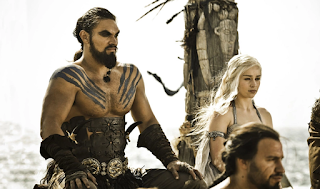Throne of the Crescent Moon Fan Art: How Habits of Whiteness Persist Beyond Works Themselves
 Saladin Ahmed's Throne of the Crescent Moon is the first novel of an anticipated trilogy. And, in a drastic change from every other fantasy series, his world features a colored majority, so much so that there are literally no white characters, a drastic departure from the hyper-white normative of the genre. Despite his clear descriptions of skin tone and very Middle Eastern setting, for whatever reason, readers, and even fans, still seem to think the characters are white. How do we know this? Take a look at the second image that pops up when you google the book's title.
Saladin Ahmed's Throne of the Crescent Moon is the first novel of an anticipated trilogy. And, in a drastic change from every other fantasy series, his world features a colored majority, so much so that there are literally no white characters, a drastic departure from the hyper-white normative of the genre. Despite his clear descriptions of skin tone and very Middle Eastern setting, for whatever reason, readers, and even fans, still seem to think the characters are white. How do we know this? Take a look at the second image that pops up when you google the book's title.
The artwork is clearly intended to be the main three characters of the book: Doctor Adoulla Makhslood, an aged ghoul hunter, Raseed bas Raseed, the Doctor's assistant, and Zamia Banu Laith Badawi, a "tribeswoman" who can take a holy form known as the Lionshape. This was likely produced by a fan, as it is not cover art, and we can make the assumption that people do not usually create such detailed artworks for something they hate. However, despite however much the artist may have enjoyed the book, the depictions come nowhere close to those provided by Ahmed's novel, aside from Adoulla's white kaftan and Raseed's blue turban.
Adoulla's age may be about right in this rendition, but his facial features, size, and skin color obviously are not. In many passages, the Doctor is identified by his large nose and overweight body. His lack of fitness is so prevalent that he frequently needs to take breaks when walking about the city or finds him out of breath after some fairly basic actions; more than anything else, Doctor Adoulla Makhslood sweats, particularly in the fashion meant to be repulsive. He is not the magical, pallid wizard Santa depicted in this fan art; he is a physically unattractive man who no one would suspect to be a hero of any sort.
Also intended to be unattractive is Zamia. When Adoullah first meets her, she is described as "a plain-faced brown girl of perhaps five and ten" with "coarse, shoulder length hair", a "boyish frame", and "homely features"; in other words, not pretty (65-70). The artist's depiction is particularly pale and delicate for Zamia given that she is explicitly described as ugly, or homely to quote verbatim. The shine and well-kept state of this artist's Zamia's hair additionally serves to further distance the interpretation from the actual intended appearance, as does the blueish eyes.
Unlike Zamia and Adoulla, however, Raseed is intended to be "pretty". From his initial appearance, Raseed is described as being "five lithe feet" tall, with "fine-boned yellow features...delicate and highlighted by tilted eyes" (14). Already, the fan art's depiction of Raseed is clearly off; his skin is a very pink shade of white and his face has generally white features: no "tilted eyes" or "fine-boned" features. Also, interestingly enough, despite the fact that Raseed is clearly described as the lightest of the bunch, Zamia has been made the lightest in this rendition. Additionally, Zamia is described as taller than Raseed, with her coming in around 5'10", and Raseed only near 5"; Raseed is noticeably taller than Zamia in this art, and also crouching slightly, signifying an even greater height difference.
-Caroline Ogden


Comments
Post a Comment